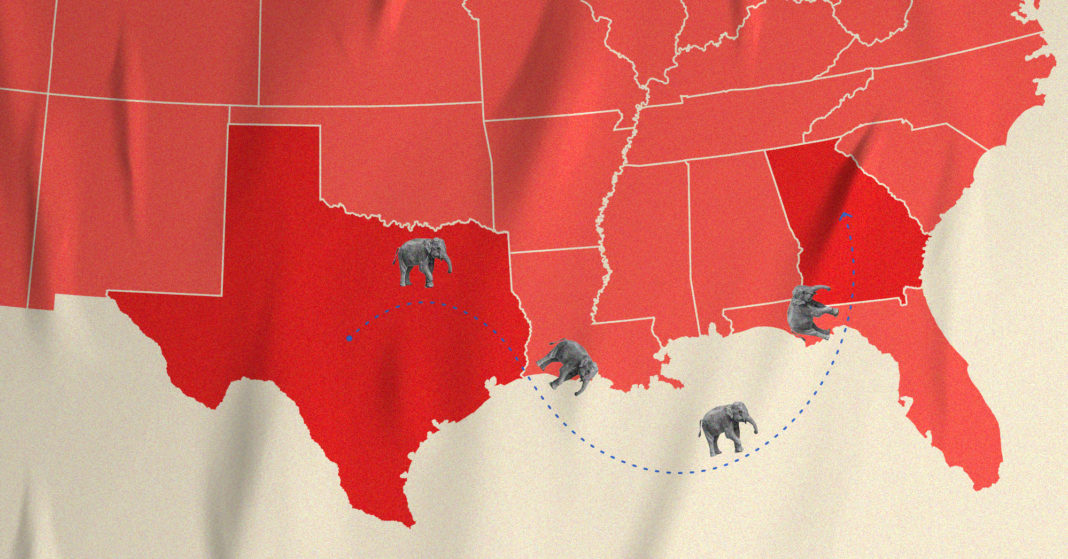Texas hasn’t always been a bastion of Republican red. At one time not so long ago, Texas was true blue and depended upon to consistently deliver victories for the Democratic party in both presidential and midterm elections. The story of how we changed is fascinating and has many twists and turns.
Blue Before
Many Texans, especially those who have moved here in the last 20 years, might be shocked to learn that Texas was the political breeding ground for some of America’s most progressive figures. These include President Lyndon B. Johnson, whose legacy would include the Civil Rights Act, the Voting Rights Act, Medicare, and the Great Society. Johnson was a Texas senator alongside Ralph Yarborough, another champion of American progressivism who notably supported the Civil Rights Movement and opposed the Vietnam War.
Texas would continue to elect Democrats even as their electoral votes would continually go toward Republican candidates. Lloyd Bentsen, a Democratic senator who served for over 20 years, would be reelected to his senate seat in 1988 — even as he lost Texas as the vice presidential candidate for Michael Dukakis. In fact, the candidate who instead won Texas’ electoral votes was George H.W. Bush, who Bentsen defeated for the Senate in 1970.
There’s also the fact that almost 30 years ago, Texas saw the governorship of Ann Richards, the state’s first woman to be elected governor, and a darling for liberals and Democrats across the nation. She first came to national prominence by insulting then-presidential-candidate George H.W. Bush at the Democratic National Convention before being elected governor in 1990. She would prove to be a popular governor both in her home state and on the national scene.
“The state of Texas liked Ann Richards, liked her a lot, liked her on the day they voted her out of office. She had an approval rating of over 50 percent” said Reggie Bashur, press secretary for future President George W. Bush, son of the man Ann Richards famously mocked, and the man who would ultimately defeat Richards in her reelection campaign.
And though Bush, who had no prior experience in public office, was initially seen as a long-shot to beat the popular governor, he outperformed expectations and defeated Richards 53-47. Richards’ defeat would be seen as the death-knell of liberalism in Texas’ political sphere.
According to Karl Rove, Bush’s chief strategist, “The state was in the midst of a pretty phenomenal partisan shift … This change was also mirrored in a shift in most rural counties from Democratic to Republican, or at least competitive for Republicans.”
So after a century of consistently voting Democratic, what led to the moment where Texas officially transitioned from Blue to Red?
Richard Nixon and the Southern Strategy
Texas had been one of many Southern states to join in the “New Deal Coalition” after the election of Franklin Delano Roosevelt. The New Deal involved a set of domestic programs such as Social Security, which was accused of being socialist in nature by Republicans. Though there’s likely not a word more despised amongst Texans today, that didn’t stop previous Texans from supporting Roosevelt’s program, or any New-Deal Democrat afterwards.
That is, until 1964.
After signing the Civil Rights of Act of 1964 into law, former Texas senator and then-President Lyndon B. Johnson famously remarked that the Democrats had “lost the south for a generation.” And Johnson’s fears were proven correct by the enactment of the Southern Strategy, a Republican attempt to win over southern voters who were outraged by the Democrats’ support of integration and civil rights.
The Southern Strategy hinged upon codified language and dog-whistling, which stoked racial animosities among white southerners without directly announcing racist intent. It also sought to characterize countercultural movements as being subversive, dangerous, and antithetical to American values. Richard Nixon would perfect this with his 1968 presidential campaign, which ran on a “law-and-order” theme, promising to restore peace and tranquility after the tumultuous political climate of the 1960s. In his campaign ads, Nixon would constantly show clips of urban riots while promising to represent the “Silent Majority.” He would also campaign against drug-use and cultural subversion, associating these issues with the counter-cultural movement of the era.
According to Republican strategist Lee Atwater, this was a deliberate attempt to appeal to white voters’ resentment of racial progress. In an infamous interview, Atwater explained that, instead of using racial slurs, “you say stuff like, uh, forced busing, states’ rights, and all that stuff, and you’re getting so abstract. Now, you’re talking about cutting taxes, and all these things you’re talking about are totally economic things and a byproduct of them is, Blacks get hurt worse than whites.”
And it was an effective strategy that slowly eroded Democratic support in Texas, where progressive movements were seen as increasingly radical and disruptive. Prominent Texas Democrats, such as former governor and protege to Lyndon B. Johnson, John Connally, would officially change party affiliations to Republican by 1973. Despite being a Democrat, he had also been a fierce rival of the more liberal Ralph Yarbourough.
After serving as secretary of the Treasury Department for the Nixon administration, Connally would start an organization, “Democrats for Nixon,” before officially switching parties in May 1973, saying that he agreed “more with Mr. Nixon’s views … than those articulated by Mr. McGovern.”
That “Mr. McGovern” would be Senator George McGovern, Nixon’s Democratic opponent in the 1972 election. Connally would double-down on his support for the Republican party would be quoted as saying that “Republicans were the only group who could save the country.” He even ran for the Republican nomination in 1980 before losing to Ronald Reagan.
Democrats’ support in Texas can also be seen dwindling in the returns for the Presidential races. While Democrats won Texas in 1964 by 63.32%, their support would be cut in half four years later, winning Texas by only 39.87% in 1968. Finally, Nixon won the Lone Star State by a staggering 66.20% in his landslide election of 1972. Meanwhile, Jimmy Carter would win Texas by a slim margin 4 years later (possibly because President Gerald Ford didn’t know how to eat a tamale). Afterwards, no other Democrat would even come close to winning the state of Texas.
‘Senator, You’re No Jack Kennedy’
The Southern Strategy is an incomplete answer to the question of Texas’ political transition. Democrats would continue to be elected to statewide office for two decades until Bush’s gubernatorial victory. There’s also the fact that other Southern states have proven to be as consistently Republican as Texas. Whereas Donald Trump won Texas by 6 points, he’s on track to lose Georgia, and to lose North Carolina by only a slim margin.
So perhaps the next place to look would be to study Texas’ last Democratic senator, the aforementioned Lloyd Bentsen. While he’s most famous for his iconic “You’re No Jack Kennedy” line against Dan Quayle, Bentsen is a legend of Texas politics, having served in Congress from 1948 to 1992, before being appointed Secretary of Treasury to the Clinton Administration.
Despite Bentsen’s proud legacy, and his political recognition as one of Texas’ last prominent Democrats, Bentsen’s path to the Senate actually represented a conservative shift for the state. After serving three terms as a Congressman, Bentsen decided to run against fellow Democrat Sen. Ralph Yarborough in order to win the Democratic nomination for the Senate.
For context, Yarborough wasn’t just a Texas Democrat, but one of the most towering figures of American liberalism, a “heroic dragon-slayer of Texas labor and Texas liberals, the only one of their number ever to achieve statewide office,” as described in Texas Monthly. Yarborough was such a staunch progressive that he made enemies of fellow party members, including John Connally. However, that didn’t stop Yarborough from being reelected in 1964, even after the passage of the Civil Rights Act.
Bentsen launched a primary campaign against Yarborough in 1970 that was akin to Nixon’s law-and-order campaign from 1968. Accusing Yarborough of being radical, Bentsen’s ads would constantly use footage of the infamous Chicago riots of ’68, asking viewers if Yarborough “represented” their views. Bentsen even went as far as to imply that Yarborough tacitly endorsed the riots by supporting anti-war candidate Eugene McCarthy.
Yarborough, who was more focused on defeating then-Congressman George H.W. Bush in the general election, didn’t respond to Benten’s attacks effectively. As a result, Bentsen defeated Yarborough and later went on to defeat Bush in the general election. Like Yarborough, Bush was unprepared for the centrist Bentsen, as the two candidates were ideologically indistinguishable from each other. According to Texas Monthly, “Bush and Bentsen seemed so alike they could easily have passed for close relations, right down to mutual memberships in the River Oaks Country Club.”
While Yarborough’s Senate seat would still be held by a fellow Democrat, Bentsen’s campaign represented a total rejection of Yarbourogh’s brand of progressivism. In fact, other Texas Democrats would actually endorse Bush over Bentsen, fearing that Bentsen’s victory would shift the party to the right.
Ironically, Bentsen would become a Democratic star after comparing Dan Quayle unfavorably to Jack Kennedy — even as he campaigned against all of Kennedy’s values and beliefs; so, perhaps Bentsen was no Jack Kennedy either.
Polarization and Hyper-Partisanship
Bentsen’s Senate race was a sound defeat for liberal Democrats, one they would never recover from. Then again, Bentsen would continue to be a party loyalist in his Senate career, and his consistent reelections gave some hope for the Democratic party.
But after the 1992 election of Bill Clinton and the Republicans’ subsequent “Contract with America,” the United States would enter an era of hyperpolarization that would further split the country along party lines. According to the Pew Research Center, “The overall share of Americans who express consistently conservative or consistently liberal opinions has doubled over the past two decades from 10% to 21% … Partisan animosity has increased substantially over the same period.”
Texas would become one of the most definitive examples, where certain key political issues would keep the GOP in power and keep the Democrats on the fringes.
Perhaps no particular issue represents the division of Texas politics better than gun rights, which would come to define the Lone Star State culturally as well as politically; and appropriately so, for there’s no issue that has resonated more with Texas voters, nor one that has come to define their party affiliation. Anyone who thinks of Texas probably thinks of the ubiquitous “Come and Take It” signs that color the entire state, from T-shirts to billboards. It’s not simply a catchphrase or slogan, for Texas is the state with the highest number of registered gun owners. That’s perhaps why Texas Republicans accuse their Democratic opponents of wanting to infringe upon the Second Amendment rights of responsible gun-owners, before cruising to re-election.
The Texas celebration of guns makes sense given the state’s history going all the way back to the Battle of the Alamo. However, the modern gun-rights movement in Texas was sparked by a horrifying massacre in the early ’90s at Killeen, Texas, where a man drove into a Luby’s restaurant before fatally shooting over 20 people.
While people in many states might respond to this incident by calling for more gun control, outraged Texans decided that they needed the right to carry firearms in case they were attacked in a similar fashion. The Waco siege of 1994 didn’t do anything to quell the outrage and encourage Texans to trust the federal government, either. Texans decided that they needed to protect themselves, which led to the movement for concealed-carry permits.
However, then-Gov. Ann Richards vetoed the legislation once it got to her desk. It’s doubtful that she knew this veto would kill her chances of reelection despite her national popularity and successful economic record. Voters would go on to choose the pro-concealed carry George W. Bush by several percentage points, which ushered in a new era of gun-rights fixation for Texas politics. As gun control has become a core tenet of the Democratic platform moving into the 21st century, it’s hard to imagine Texans being anything less than skeptical of Democratic candidates in the future. According to Ed Martin, then-executive director of the state Democratic party, anyone who opposed gun-rights was “Satan incarnate” to the gun lobby.
Many other key issues would taint the Democratic party in the eyes of Texans. A state whose economy is based on the oil-and-gas economy, Texas was not keen on legislative agendas such as the Green New Deal, which the Texas Public Policy Foundation claimed would put the Lone Star State “in the red.”
Tom DeLay and Gerrymandering
Gov. George W. Bush won reelection in 1998 by the most substantial landslide of any gubernatorial race in Texas history, pulling in over 70% of the vote. After he vacated the governor’s office for the presidency, his successor, Rick Perry, would win the 2002 gubernatorial election. That didn’t cement the Republican ownership over Austin though, since Rick Perry had run as a pragmatic Republican open to bipartisanship.
“I’ve been painted as a partisan, but I’m no more of one than Speaker Laney or any other Democrat state officeholder,” Perry told Texas Monthly before the election. “I look forward to 2003 to work with people.”
This is a stark contrast from the Perry who ran for president in 2012 as a Tea Party darling who wanted to cut major departments such as Education, Commerce and Energy; or the Perry who decried the Affordable Care Act as “socialism on American soil.” So what happened the following decade that enabled this brazen partisanship?
The figure who did the most to kill the Texas Democrats wasn’t George W. Bush, Rick Perry, or any other looming figure in Texas politics. Instead, it was Representative Tom DeLay, who in 2003, orchestrated one of the most seismic shifts of political representation in the state’s history.
After Republicans secured the Texas Legislature in 2002, DeLay led the charge in redrawing Texas’ districts five years before the 2010 census. DeLay’s proposed map would automatically add 5 to 7 Republicans to the Texas Legislature and would force Texas Democrats to relocate to other, more secured districts.
According to David Vance, a strategist for the representative democracy watchdog Common Cause, the Republicans “smelled blood in the water.” He went on to say that, “The Republican majority, egged on by Tom DeLay, decided to take their legislative majority for a spin and redraw the districts mid-decade.”
There was so much outrage from Texas Democrats that a group of State Senators known as “The Killer Bees” decided to not attend the legislative session in order to stonewall the redistricting efforts. In the Texas Legislature, at least two-thirds of representatives must be in attendance for the session to move forward. So, with at least 67 Senate Democrats, their absence would be enough to block passage of the bill.
At least, that was the plan. But one lone Senate Democrat, John Whitmire, decided to return to the State Senate, allowing Republicans to pass the legislation. And with that, a fatal blow was struck to Texas Democrats. Many Representatives saw their districts disappear, and the Texas Republicans ensured their control of the Legislature. According to Joby Fortson, aide to Republican Joe Barton, DeLay’s map had “a real national impact that should assure that Republicans keep the House no matter the national mood.”
What’s Next
Fortson was correct: the Democrats have consistently failed to regain the Texas Legislature since 2002, no matter which political direction the rest of the country headed in. Texas Democrats have challenged the legality of DeLay’s map several times, but a Supreme Court ruling in 2011 upheld DeLay’s gerrymandering. Now, with Republicans reclaiming the House and Senate after the 2020 election, Democrats’ hopes for redrawing the state’s district maps are practically doomed.
While some Democrats may have seen a pathway to statewide victory through Beto O’Rourke’s Senate campaign, the Democrats’ subsequent defeat seemed to halt the momentum. While President-elect Joe Biden managed to outperform expectations in certain red districts, his prospects were crushed by President Donald Trump’s success with the Latino community. As a result, Biden even lost in blue districts that had been carried by former Secretary of State Hillary Clinton.
Biden wasn’t the Democrat to recapture Texas. In fact, the record-breaking turnout this year may have hurt the Democrats more than it helped, as Trump exceeded previous support among Republicans nationwide in 2020. Perhaps the political climate makes Democratic policies no longer viable for many Texan voters; but there’s a reason that both parties have treated Texas as a battleground state: the numbers are there. There is a vast Democratic presence in the Lone Star State that has been diluted by gerrymandering.
Neither party should count Texas out nor take it for granted. Texas’ history has been defined by a bold and tenacious spirit, along with brave, unabashed figures. Texas Democrats will continue fighting because that’s what Texans do.








